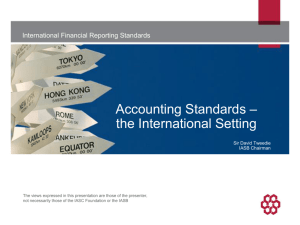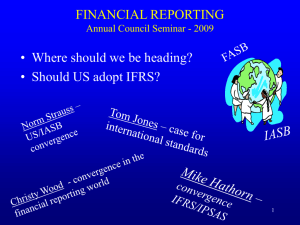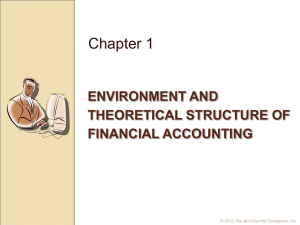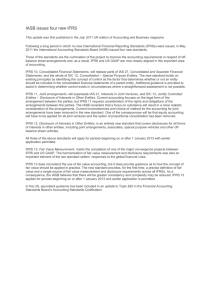TD United Nations Conference on Trade and Development United Nations
advertisement
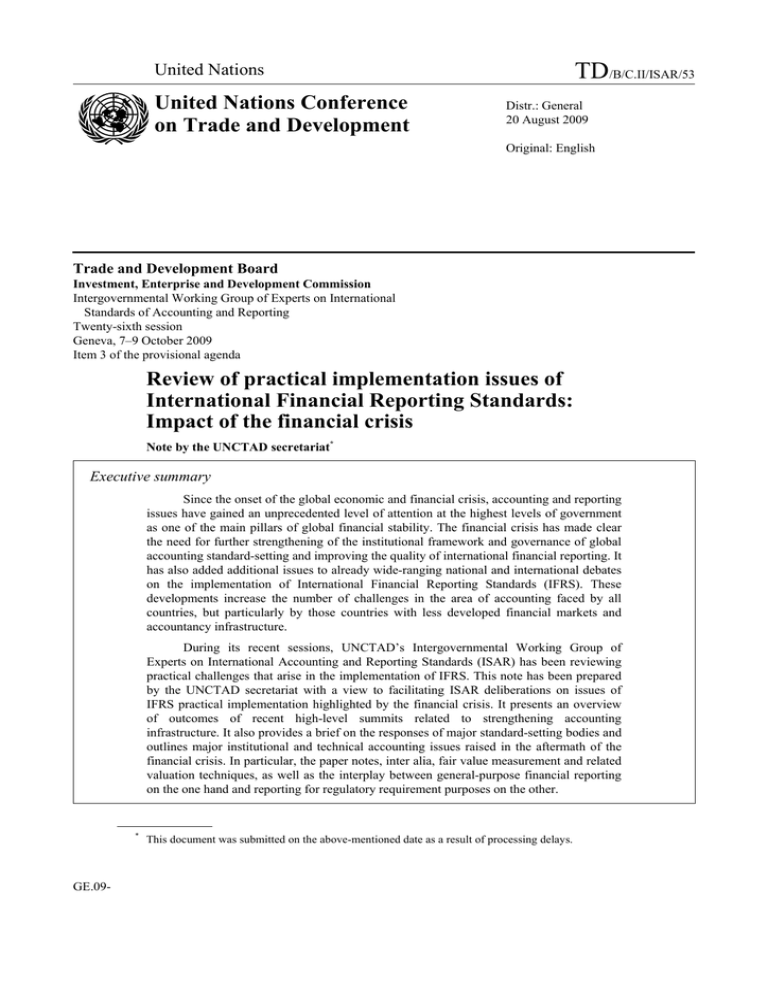
TD/B/C.II/ISAR/53 United Nations United Nations Conference on Trade and Development Distr.: General 20 August 2009 Original: English Trade and Development Board Investment, Enterprise and Development Commission Intergovernmental Working Group of Experts on International Standards of Accounting and Reporting Twenty-sixth session Geneva, 7–9 October 2009 Item 3 of the provisional agenda Review of practical implementation issues of International Financial Reporting Standards: Impact of the financial crisis Note by the UNCTAD secretariat* Executive summary Since the onset of the global economic and financial crisis, accounting and reporting issues have gained an unprecedented level of attention at the highest levels of government as one of the main pillars of global financial stability. The financial crisis has made clear the need for further strengthening of the institutional framework and governance of global accounting standard-setting and improving the quality of international financial reporting. It has also added additional issues to already wide-ranging national and international debates on the implementation of International Financial Reporting Standards (IFRS). These developments increase the number of challenges in the area of accounting faced by all countries, but particularly by those countries with less developed financial markets and accountancy infrastructure. During its recent sessions, UNCTAD’s Intergovernmental Working Group of Experts on International Accounting and Reporting Standards (ISAR) has been reviewing practical challenges that arise in the implementation of IFRS. This note has been prepared by the UNCTAD secretariat with a view to facilitating ISAR deliberations on issues of IFRS practical implementation highlighted by the financial crisis. It presents an overview of outcomes of recent high-level summits related to strengthening accounting infrastructure. It also provides a brief on the responses of major standard-setting bodies and outlines major institutional and technical accounting issues raised in the aftermath of the financial crisis. In particular, the paper notes, inter alia, fair value measurement and related valuation techniques, as well as the interplay between general-purpose financial reporting on the one hand and reporting for regulatory requirement purposes on the other. * GE.09- This document was submitted on the above-mentioned date as a result of processing delays. TD/B/C.II/ISAR/53 The note concludes with a number of key questions for the Group of Experts to deliberate upon, including: • What are major institutional challenges in the area of accounting and reporting brought to light by the recent financial crisis? • Are there some additional practical implementation issues that countries have been experiencing with regard to the impact of the financial crisis on financial reporting requirements and IFRS? • What kind of assistance do countries need to keep pace with international developments in relation to accounting – especially in the aftermath of the financial crisis – and what particular role could ISAR play in addressing these challenges? Contents Page 2 I. Introduction................................................................................................................................... 3 II. Financial reporting and auditing issues that emerged during the financial crisis .......................... 5 III. Selected issues............................................................................................................................... 7 IV. Concluding remarks ...................................................................................................................... 11 TD/B/C.II/ISAR/53 I. Introduction 1. UNCTAD’s Intergovernmental Working Group of Experts on International Standards of Accounting and Reporting (ISAR) has been reviewing practical implementation issues relating to International Financial Reporting Standards (IFRS). This work has been conducted within the context of the widespread adoption of IFRS in recent years, and within ISAR’s mandate to promote the harmonization of international accounting and reporting. ISAR’s work in this area includes issues pertaining to institutional and regulatory arrangements, enforcement mechanisms, technical issues and capacity-building. The objective of this work is to assist developing countries and countries with economies in transition in their efforts towards the practical implementation of IFRS. The work has been grounded in the sharing of best practices and lessons learned from actual country experiences with IFRS. 2. The financial crisis that besieged the world economy beginning in the summer of 2007 has had broad negative impact around the world. For example, in the area of foreign direct investment (FDI), recent UNCTAD figures suggest that, after a peak of $1.9 trillion in 2007, global FDI plunged by 15 per cent in 2008.1 The prospects for 2009 are not good either. In fact, UNCTAD’s latest survey on FDI prospects indicates that sustained FDI flows will not resume before 2011.2 With respect to world merchandise trade, UNCTAD’s studies project a 6 per cent–8 per cent decline. Exports from developing countries and transition economies are also expected to fall, in the range of 7 per cent–9 per cent. According to the World Bank, global output is expected to decrease this year by 2.9 per cent – the first-ever decline since the Second World War. The International Labour Organization expects the number of unemployed persons to rise to 50 million in 2009.3 Hunger has also risen dramatically, with the number of hungry people up by 100 million since last year alone, bringing the total number to 1 billion – one of every six people on this planet. 3. Since the onset of the global economic and financial crisis, accounting and reporting issues have gained an unprecedented level of attention at the highest levels of government. A wide range of key actors have been devoting significant attention to the role of accounting and reporting in the context of the financial crisis, including the 2008 and 2009 Summits of the Group of Twenty (G-20), the June 2009 meeting of the G-8 Finance Ministers, the European Council of Ministers; the United States Congress and the Financial Crisis Advisory Group (established by the International Accounting Standards Board (IASB) and the Financial Accounting Standards Board (FASB) of the United States). The attention paid to this subject reflects a growing recognition of the importance of a sound accounting and reporting system for global financial and economic stability. 4. All of the major international meetings since the twenty-fifth session of ISAR in 2008 have reconfirmed the need for a single set of high-quality global accounting standards. The international community has underscored the importance of strengthening cooperation and coordination among global standard-setters, regulators, supervisors and national standard-setters, with the goal of ensuring high-quality, comparable financial reporting and consistent application and enforcement of accounting standards. Also outlined at these various international meetings were a number of priority issues in this area 1 2 3 http://www.unctad.org/en/docs/webdiaeia20091_en.pdf. http://www.unctad.org/en/docs/diaeia20098_en.pdf. http://www.ilo.org/wcmsp5/groups/public/---dgreports/--dcomm/documents/publication/wcms_101461.pdf. 3 TD/B/C.II/ISAR/53 which need to be addressed urgently to improve the global financial architecture and restore investor confidence. 5. At the June 2009 United Nations Conference on the World Financial and Economic Crisis and Its Impact on Development, member States stressed the importance of strengthening the international financial system to overcome severe impacts of the current crisis and to help prevent the occurrence of similar crises in the future. In this regard they called for, inter alia, concerted efforts by all jurisdictions towards consistent and nondiscriminatory implementation of corporate transparency requirements and related international standards.4 6. These developments have added additional issues to already wide-ranging national and international debates on the implementation of IFRS. Established issues within this area already included (a) the complexity of accounting standards; (b) the need for additional guidance on their practical implementation (especially in such areas as valuation of financial instruments); (c) the suitability of international accounting standards for small and medium-sized enterprises; and (d) a number of other important technical matters (e.g. fair value measurement). Adding to this field, a new group of issues has now emerged related to financial reporting in a distressed economic situation. These include such challenges as (a) measurement in illiquid markets; (b) pro-cyclicality of IFRS; (c) provisioning aspects; (d) and risk management and related disclosures and audit considerations. One of most important new issues to have emerged in these debates is how to ensure that the financial reporting system not only provides a fair and objective reflection of company’s financial status and performance, but also provides early warning signals which can help to avert major financial disasters. These new issues add to previously existing challenges for all countries, but particularly for those countries with less developed financial markets and accountancy infrastructure. 7. Another major aspect of the accounting-related global agenda in the wake of the financial crisis is the need to strengthen the institutional framework for the creation of one set of global accounting standards. This includes the need to re-evaluate the governance of global standard-setting institutions to ensure the integrity and independence of the process. The financial crisis has highlighted tensions between the need for expediency in stabilizing economies, and the need for due process in creating a single high-quality international standard. 8. Therefore, gaining a deeper understanding of the impact of the financial crisis on accounting and reporting has become essential for assisting member States with their efforts towards the harmonization of their financial reporting requirements and the implementation of IFRS. The UNCTAD secretariat has prepared this note with a view to facilitating ISAR’s deliberations on this matter. 9. This note presents an overview of the practical implementation issues of IFRS that emerged during the financial crisis. It has been prepared on the basis of inputs provided by the panellists and participants of the July 2009 Conference on the Financial Crisis and its Implications for the International Financial Reporting Architecture and Financial Stability, which was organized by UNCTAD at the request of the twenty-fifth session of ISAR. 4 4 See “Conference on the World Financial and Economic Crisis and Its Impact on Development”. United Nations, New York, 24–25 June 2009, A/Conf.214/3. TD/B/C.II/ISAR/53 II. Financial reporting and auditing issues that emerged during the financial crisis A. Impact of the financial crisis on the global accounting agenda 10. The financial crisis originated in the subprime mortgage market of the United States, and rapidly spread throughout the global financial sector, with knock-on effects for the real economies of countries around the world. Subprime mortgage loans are distinct due to the fact that such loans are made to high-risk borrowers, usually with poor credit history. In the ordinary course of business, mortgage banks packaged and transformed these subprime mortgage loans into securities that were sold to investors around the world. 11. The global financial crisis that was triggered by the collapse of the subprime mortgage market in the United States has been the subject of extensive debate and examination by different stakeholders at the national, regional and international levels. In recent decades, the world economy has been integrating at a rapid pace. One of the manifestations of the growing integration of financial markets has been the highly correlated movements of equity markets around the world. A direct implication of this rapidly globalizing world economy has been the emergence of global standards, including in the area of financial reporting. The number of countries and jurisdictions that require or permit the use of International Financial Reporting Standards has reached 113.5 Global standards, such as IFRS, facilitate the flow of information to market participants by enabling the measurement and reporting of economic activities in a comparable manner, regardless of the jurisdiction where the economic activity takes place. 12. The financial crisis has given accounting and financial reporting debates a new prominence and moved these issues into the highest levels of government and intergovernmental discussion. Working Group 1 of the G-20 on Enhancing Sound Regulation and Strengthening Transparency6 identified the following as drivers of the current turmoil: (a) Weaknesses in underwriting standards; (b) Lack of oversight of systemic risks; (c) Lack of oversight of unregulated pools of capital; (d) Weak performance by credit rating agencies; (e) Pro-cyclical tendencies fed by regulatory and accounting frameworks; (f) Shortcomings in risk management practices; (g) Financial innovation outpacing risk management; (h) Weaknesses in disclosure; (i) Weaknesses in resolution procedures; and (j) Lack of transparency in various over-the-counter markets.7 13. In its declaration of 2 April 2009, the G-20 agreed that accounting standard-setters should take action by the end of 2009 to: 5 6 7 http://www.ifrs.com/ifrs_faqs.html#q3. Created by the 2008 G-20 Summit. G-20 Working Group 1 – Enhancing Sound Regulation and Strengthening Transparency, Final Report, 25 March 2009 (http://www.g20.org/Documents/g20_wg1_010409.pdf). 5 TD/B/C.II/ISAR/53 (a) Reduce the complexity of accounting standards for financial instruments; (b) Strengthen accounting recognition of loan-loss provisions by incorporating a broader range of credit information; (c) Improve accounting standards for provisioning, off-balance sheet exposures and valuation uncertainty; (d) Achieve clarity and consistency in the application of valuation standards, internationally, working with supervisors; (e) Make significant progress towards a single set of high quality global accounting standards; (f) Within the framework of the independent accounting standard-setting process, improve the involvement of stakeholders, including prudential regulators and emerging markets, through IASB’s constitutional review. 14. As a result of the G-20 summit in April 2009, the Financial Stability Board (FSB) was established as a stronger successor to the Financial Stability Forum. FSB was tasked with, inter-alia, calling on accounting standard-setters to work urgently with regulators to improve standards on valuation and provisioning, with a view to achieving a single set of high-quality global accounting standards. B. Responses of major accounting standard-setters 15. In response to the financial crisis, IASB has launched a number of projects, such as fair value measurement and financial instruments. In October 2008, IASB amended requirements on the reclassification of some financial assets from fair value categories to amortized cost categories.8 IASB has also issued additional technical guidance on the determination of fair values of financial assets in illiquid or inactive markets.9 The guidance explains the need to consider all relevant market information and acknowledges that, in some circumstances, an entity may have to use its own assumptions about future cash flows and risk-adjusted discount rates. This guidance has been reinforced by the May 2009 exposure draft Fair Value Measurement.10 16. The IASB project on financial instruments will have three phases: (a) classification and measurement; (b) impairment; and (c) hedge accounting and others. The classification and measurement phase is aimed at producing decision-useful information about amounts, timing and uncertainty of cash flows. IASB is proposing two measurement methods (amortized cost and fair value) to be used depending on the circumstances. Amortized cost would be used only when assets have basic features of a loan and are managed on a contractual yield basis. All other financial instruments are to be measured on fair value basis with the fair value option available in case of mismatches between assets and liabilities. 17. At the end of 2008, IASB and FASB established the Financial Crisis Advisory Group, which was tasked to advise both IASB and FASB on the implications of the 8 9 10 6 http://www.iasb.org/NR/rdonlyres/BE8B72FB-B7B8-49D9-95A3CE2BDCFB915F/0/AmdmentsIAS39andIFRS7.pdf IASB (2008). Measuring and disclosing the fair value of financial instruments in markets that are no longer active. IASCF. October. London (http://www.iasb.org/NR/rdonlyres/0E37D59C-1C74-4D61A984-8FAC61915010/0/IASB_Expert_Advisory_Panel_October_2008.pdf). http://www.iasb.org/NR/rdonlyres/C4096A25-F830-401D-8E2E9286B194798E/0/EDFairValueMeasurement_website.pdf. TD/B/C.II/ISAR/53 financial crisis to the standard-setting process and potential changes in the regulatory environment. At the end of July 2009, the advisory group concluded that the financial crisis had underscored the importance of four principles:11 (a) Effective financial reporting; (b) Limitations of financial reporting; (c) Convergence of accounting standards; and (d) Standard setter independence and accountability. 18. During the advisory group’s debates a number of specific accounting issues were raised: (a) Valuation and measurement in illiquid markets (particularly of financial instruments); (b) Pro-cyclicality of accounting standards; (c) Provisioning, risk management and disclosures; and (d) Reconciliation between financial reporting and prudential regulations. 19. The advisory group made a number of recommendations in each of above listed areas. A more general question raised by the group was what role accounting and audit could play in providing early warning signals regarding potentially dangerous financial practices. 20. The Committee of European Securities Regulators (CESR) conducted a study of the application of and disclosures related to the amendment on International Accounting Standard (IAS) 39 and IFRS 7 that were made in October 2008.12 CESR selected a sample of 100 European financial companies, of which 61 per cent opted for the reclassification option. III. Selected issues A. Measurement issues 21. In the aftermath of the financial crisis, most of the debate has been focused on measurement issues, particularly in relation to financial instruments. Measurement is a key element in accounting and financial reporting. The measurement process determines the monetary value that will be assigned to items that will be reported in the financial statements of an entity. Over the years, as the activities of enterprises have grown and financial markets have developed, different measurement approaches have evolved. Users of financial statements have different measurement preferences. For example, financial analysts support measurement approaches based on fair value. On the other hand, prudential regulators support measurement approaches that can be easily verified, for example, historical costs. 11 12 Report of the Financial Crisis Advisory Group, 28 July 2009 (http://www.iasb.org/News/Press+Releases/Financial+Crisis+Advisory+Group+publishes+wideranging+review+of+standard-setting+activities+followi.htm). Committee of European Securities Regulators (2009). Application of and disclosures related to the classification of the financial instruments. CESR/09-575. 15 July. 7 TD/B/C.II/ISAR/53 22. For many years, measurement has been the subject of extensive debate among various stakeholders, a debate which has intensified significantly in the aftermath of the financial crisis. One of key issues raised has been the role of fair value accounting in the financial crisis, including its relevance, reliability and applicability in the case of market uncertainty and illiquidity. Some experts argue that measuring assets at fair vale has led to unwarranted write-downs in the present value of still-performing long-term assets whose long-term value remains unchanged; thus, it is argued, fair value accounting has been misleading to investors and other users of such information about the real value of such assets. This argument contends that unwarranted write-downs in the value of long-term assets led to panic selling of certain mortgage-backed financial instruments and the subsequent collapse in these markets that triggered the financial crisis.13 23. Others argue that fair value accounting is useful under normal market conditions, but becomes practically unworkable during periods of illiquid markets and rapid price fluctuations that mark a financial crisis. For example, a survey conducted in 2009 by Valuation Research Corporation (VRC) indicated that a majority of surveyed financial professionals believed that, while in less volatile times fair value accounting has improved transparency, during times of financial distress it becomes more difficult to implement and understand.14 24. Another view is that, despite its imperfections, fair value measurement, provides a far better platform for the price adjustment process needed during financial distress. This argument contends that other measurement models (e.g. amortized cost accounting) have also been subject to asset impairment write-downs. Thus, the role of asset measurement in the financial crisis would have been similar even under alternatives to fair value accounting standards. Nevertheless, proponents of fair value measurement agree that guidance on its application during periods of market distress needs to be improved.15 25. Responding to recent debates, IASB has continued its efforts towards improving requirements on fair value measurement. In the Exposure Draft IASB issued in May 2009,16 fair value is defined as the price that would be received to sell an asset or paid to transfer a liability in an orderly transaction17 between market participants at the measurement date. This definition is consistent with the one in Statement of Financial Accounting Standards (SFAS) No.157 Fair Value Measurements,18 issued by FASB in the United States. 26. IASB’s new Exposure Draft on Fair Value Measurement proposes use of valuation techniques for estimating the prices at which an orderly transaction would take place between participants at the measurement date. Examples of such valuation techniques include matrix pricing, present value and option pricing models (such as the Black– Scholes–Merton formula). 13 14 15 16 17 18 8 For more details see Ryan SG (2008). Accounting in and for the subprime crisis. The Accountancy Review. Vol. 83, No. 6. Survey: Perceptions of Fair Value Accounting Hit Hard by Financial Crisis. Valuation Research Corporation (VRC), 13 July 2009. See e.g. Ryan SG (2008). Accounting in and for the subprime crisis. The Accountancy Review. Vol. 83, No. 6. http://www.iasb.org/NR/rdonlyres/C4096A25-F830-401D-8E2E9286B194798E/0/EDFairValueMeasurement_website.pdf. An orderly transaction is a transaction that assumes exposure to the market for a period before the measurement date to allow for marketing activities that are usual and customary for transactions involving such assets or liabilities; it is not a forced transaction (e.g. a forced liquidation or distress sale). http://www.fasb.org/pdf/aop_FAS157.pdf. TD/B/C.II/ISAR/53 27. All valuation techniques require the use of inputs, for example, prices, cash flows, income, expenses and interest rates. The IASB exposure draft proposes that an entity must maximize the use of relevant observable inputs and minimize the use of unobservable inputs. Its proposed hierarchy of inputs, derived from SFAS 157, gives the highest priority to quoted prices (unadjusted) in active markets for identical assets or liabilities and the lowest priority to unobservable inputs. Therefore, the fair value of an asset which is determined solely by reference to quoted prices (unadjusted) in active markets for identical assets is described as a Level 1 Fair Value, or the most reliable in the hierarchy. Level 2 inputs are inputs other than the quoted prices included within Level 1 that are observable for the asset or liability, either directly (as prices) or indirectly (as derived from prices). This includes quoted prices for similar assets or liabilities in active markets. 28. The fair value of an asset that relies significantly on unobservable inputs (for example, entity-specific cash flows) is described as a Level 3 Fair Value. The exposure draft proposes extensive disclosures about the valuation techniques used and the inputs used in the chosen techniques. In addition, Level 3 Fair Value requires the disclosure of the effect of the measurements on profit or loss or other comprehensive income. 29. In practice (and as noted in the table below), preparers tend to use Level 2 inputs for fair value measurement purposes. The table below presents the aggregate results of a study of financial institutions’ use of the fair value hierarchy of assets and liabilities in the United States and Europe.19 Use of inputs for fair value measurement by financial institutions in the United States and Europe (%) Level 1 Level 2 Level 3 United States financial institutions 22 72 6.4 European financial institutions 28 67 4.4 Total (United States and European) 25 69 6.4 Source: Fitch Ratings, based on 2007 company annual reports. 30. When observable market data are not available, preparers use mathematical models for valuation purposes. This is commonly known as “mark-to-model”. This valuation process depends on significant inputs that are based on managers’ judgment. The objective of the model is to arrive at prices that would be equivalent to quoted prices had a market existed for the particular financial instrument for which the preparer needed to obtain fair value. Therefore, the model needs to simulate, as close as possible, prevailing market conditions. Formulating such a model in an objective manner, particularly in a market downturn, is challenging. Use of Level 3 inputs proves to be a significant challenge for market participants. The above-mentioned VRC survey has indicated that financial professionals feel least confident about these valuations, particularly for assets held by banks, hedge funds and private equity firms.20 31. The financial crisis has also brought into focus fair value measurement requirements in relation to an entity’s own debt. IFRS require that, if an entity’s credit standing suffers and its obligations with respect to its own debt instruments decrease, that entity should recognize a gain equal to the amount of the decline in its obligations. The general view is that it would be counterintuitive to recognize a gain in such circumstances. However, there 19 20 The total for Levels 1, 2, and 3 may not add up to 100 per cent due to rounding of numbers. Survey: Perceptions of Fair Value Accounting Hit hard by Financial Crisis, Valuation Research Corporation, 13 July 2009. 9 TD/B/C.II/ISAR/53 are differing views on this issue. Some are of the view that there should be symmetry in accounting for assets and liabilities and any accounting mismatch should be avoided. B. Audit issues 32. The financial crisis has also highlighted a number of issues in the area of auditing. In October 2008, the International Auditing and Assurance Standards Board issued a practice alert with respect to challenges in auditing of fair value accounting estimates.21 The staff alert noted that, in the market environment that prevailed at that time, obtaining reliable information relevant for fair value accounting had become one of the greatest challenges faced by preparers, and consequently by auditors. It also noted that, as markets became inactive, the tendency had been for preparers to move away from valuation by market price to valuation by model. It drew auditors’ attention to the degree of consistency of valuation approaches and the appropriateness of changes in approaches or assumptions that preparers made in arriving at fair value estimates. Additional considerations the staff alert addressed include the increased risk of fraudulent financial reporting, “going concern”22 assumptions, and the independent auditor’s report (particularly in relation to the emphasis of matter with regard to fair value estimates). C. IFRS and national regulatory requirements 33. Another challenging area of the practical implementation of IFRS that has been amplified by the financial crisis is the interplay between financial reporting information and regulatory requirements (particularly capital requirements). It is broadly recognized that financial statements prepared under IFRS are for general purpose use rather than for regulatory purposes. However, regulators in some jurisdictions utilize general purpose financial statements as an initial input and then adjust the figures to meet regulatory reporting requirements. 34. During periods of declining markets, entities are required to continue measuring their financial instruments by applying fair value measurement requirements. As a result, entities are forced to recognize significant losses, thereby decreasing their total assets and capital and then facing the possibility of failing to meet regulatory capital requirements. Other entities in the real sector may also fail to meet their debt covenants. 35. Some regulators are proposing use of dynamic provisioning throughout the economic cycle as a way of mitigating the current incurred loss model23 in IFRS. The joint IASB and FASB Financial Crisis Advisory Group noted that prudential regulators may require institutions to adopt a wide range of measures, such as establishing regulatory provisions or reserves beyond the provisioning required by accounting standards. Some 21 22 23 10 International Auditing and Assurance Standards Board (2008). Challenges in Auditing Fair Value Accounting Estimates in the Current Market Environment. October. In preparing financial statements, “going concern” is one of the underlying assumptions that an entity will continue its operations for the foreseeable future and its does not plan to liquidate or curtail materially the scale of its operations. The incurred loss model in IFRS requires an entity to recognize an impairment loss if a credit loss has been incurred and not to recognize an impairment loss for losses expected as a result of future events or future credit losses that have not been incurred. TD/B/C.II/ISAR/53 academic studies24 indicate that one way to tackle the pro-cyclicality of the accounting system is to deviate from market prices in situations when contagion is likely to occur. IFRS allows such deviations in certain circumstances. IFRS states that market prices from forced sales should not be used. This protects against negative spillovers from distressed banks. As part of its reconsideration of its requirements for financial assets and financial liabilities, IASB is seeking inputs from parties concerned regarding the feasibility of the dynamic provisioning model favoured by some banks and bank regulators.25 The joint IASB and FASB Financial Crisis Advisory Group noted that, if an alternative to the incurred loss model is developed that uses more forward-looking information, it may well narrow the difference between the requirements of the accounting standards and regulatory standards. To the extent that differences remain, the advisory group urged IASB and FASB to develop a method of transparently depicting any additional provisions or reserves that may be required by regulators, without undermining the integrity of financial reporting by affecting income statement-based metrics. IV. Concluding remarks 36. The financial crisis has made clear the need for further strengthening the institutional framework and governance of global accounting standard-setting and improving the quality of international financial reporting. A number of financial reporting and auditing issues have emerged. Most of the debate has been focused on fair value measurement and related valuation techniques. Similar issues have also emerged from the audit perspective. The interplay between general purpose financial reporting, on the one hand, and reporting for regulatory requirement purposes, on the other, has been a topic of significant debate. 37. This note has presented an overview of the impact of the financial crisis on the IFRS debate and on practical implementation challenges of IFRS. Delegates at the twenty-sixth session of ISAR may wish to deliberate on the following issues: (a) What are major institutional challenges in the area of accounting and reporting brought to light by the recent financial crisis? (b) Are there some additional practical implementation issues that countries have been experiencing with regard to the impact of the financial crisis on financial reporting requirements and IFRS? (c) What kind of assistance do countries need to keep pace with international developments in relation to accounting especially in the aftermath of the financial crisis and what particular role could ISAR play in addressing these challenges? 24 25 Laux C and Leuz C (2009). The crisis of fair value accounting: making sense of the recent debate. Working Paper No. 33, Initiative on Global Markets, the University of Chicago, Booth School of Business – last revised 1 June 2009 (http://papers.ssrn.com/sol3/papers.cfm?abstract_id=1392645). http://www.iasb.org/NR/rdonlyres/CA916D12-9B8E-4889-B75DD305DD413974/0/RequestforInformation.pdf. 11


